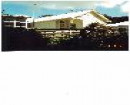FORMER METHODIST CHURCH
26-30 FORD STREET BEECHWORTH, INDIGO SHIRE
-
Add to tour
You must log in to do that.
-
Share
-
Shortlist place
You must log in to do that.
- Download report
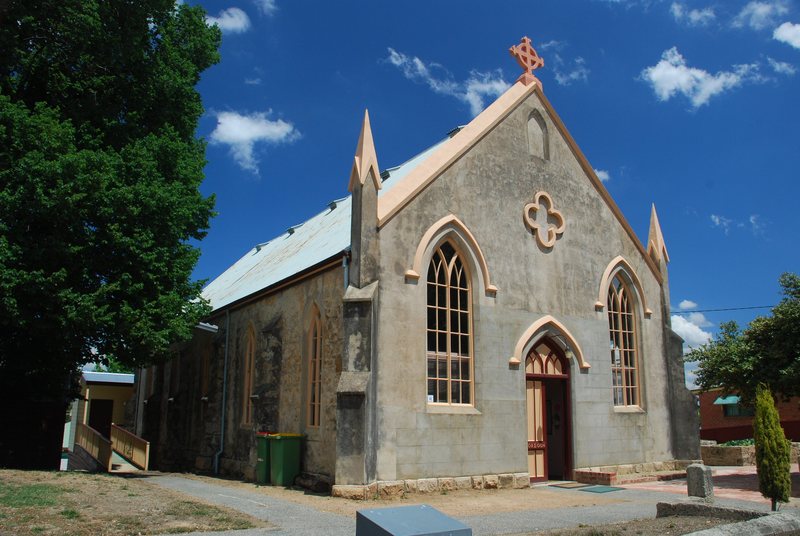

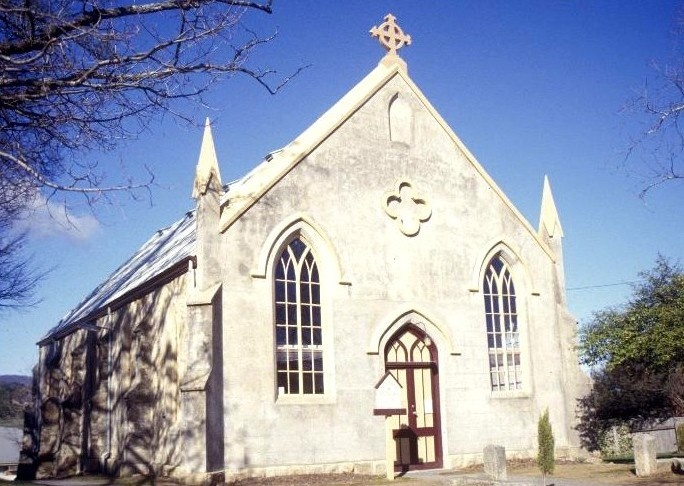
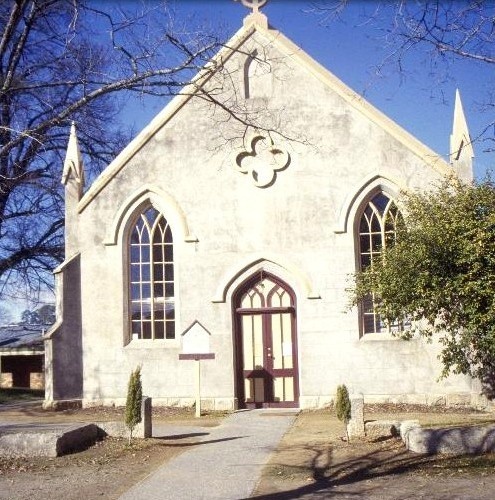
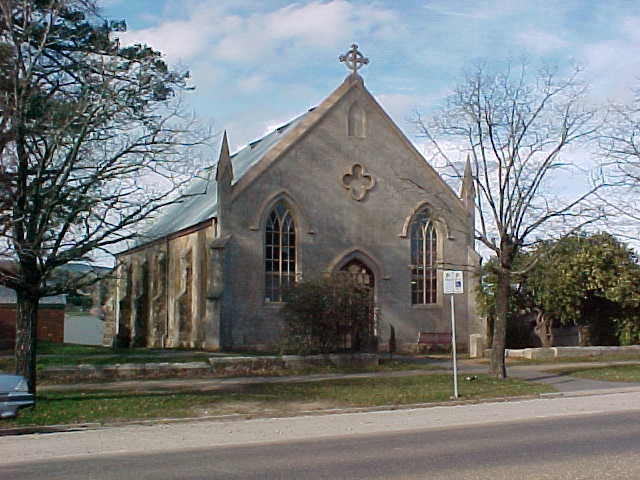








Statement of Significance
What is significant?
The 1857 former stone church and the 1869 former Sunday school building.
History Summary
The first Methodist services in Beechworth were held in the open air by a local Methodist miner and lay preacher, and later services were conducted by visiting preachers in a tent. The first permanent Methodist minister was appointed in 1854, when a timber schoolhouse was erected (on the site of the present Sunday school building), which was used on Sundays for services and Sunday school classes. The construction of the present stone church, which was the first permanent church building on the Ovens goldfields, was initiated by Rev John Christian Symons, who came to Beechworth as minister in 1856. He was later to make important contributions to the Methodist Church in Victoria. The foundation stone of the church was laid in January 1857 and the building was completed in April of the same year at a cost of £2105/14/6. The architects were Powell & Clarke and the builder was Benjamin Jarvis of Collingwood. Small extensions were made to the church in 1858. The Sunday School had been active from 1854, when 35 children were enrolled, and numbers rose to 497 in 1867. In 1869 a new brick Sunday School building replaced the 1854 building. The church was made redundant following the amalgamation of the Methodist and Congregational Churches in Beechworth in 1966, after which the church and Sunday school buildings were purchased by the Shire, serving a number of public purposes before becoming a neighbourhood centre in 1985.
Description Summary
The Former Methodist Church is a simple Gothic style building of local granite rubble, stuccoed on the front and rear gabled facades, and with a corrugated iron roof. The front facade has angled corner buttresses with stylised pinnacles, a quatrefoil and blind lancet in the gable, drip moulds over the windows and central door, and an Irish cross at the head of the gable. The building is notable for its use of local granite, giving it a character peculiar to the Beechworth area. The delicate Gothic glazing bars on the windows appear to have survived intact. A timber extension has been made at the rear of the building to accommodate a commercial kitchen, associated with the building's use as a neighbourhood community centre. The former Sunday school building is a red brick gabled Gothic style building on a similar scale to the church. At the front is a small entrance porch with decorative bargeboards in the gable. Between the two buildings is a large elm and on the street corner outside the brick building is a large oak tree.
How is it significant?
The Former Methodist Church, Beechworth is of architectural and historical significance to the State of Victoria. It satisfies the following criterion for inclusion in the Victorian Heritage Register:
Criterion A Importance to the course, or pattern, of Victoria's cultural history
Criterion D Importance in demonstrating the principal characteristics of a class of cultural places and objects
Why is it significant?
The Former Methodist Church, Beechworth is significant at the State level for the following reasons:
The Former Methodist Church, Beechworth is historically significant as one of the first permanent churches built on the Victorian goldfields, and the first on the Ovens goldfield. It demonstrates the rapid development which occurred in the goldfield towns following the discovery of gold in the early 1850s. It reflects the importance of Methodism in Victoria at this time, and the early activities of the Wesleyan Methodist Church in taking their religious message to the gold miners. The Sunday school building demonstrates the importance of the religious education of children during the nineteenth century. [Criterion A]
The Former Methodist Church, Beechworth is architecturally significant as a demonstration of the simple church buildings constructed on the goldfields in the 1850s. It demonstrates the Wesleyan Methodist precept of simplicity in form and economy of construction for their church buildings. Its primitive Gothic design relates directly to the church's origins in Scotland. [Criterion D]
The Former Methodist Church, Beechworth is also significant for the following reasons, but not at the State level:
The Former Methodist Church is significant for its association with the early history of Beechworth. It is the oldest surviving church building in the town. The construction of the church is notable for its use of local granite, giving it a character that is peculiar to the Beechworth area. The simple composition, decoration and distinctive stone construction is typical of Beechworth's early buildings. It is historically significant for its association with the Rev John Christian Symons, who initiated the construction of the church and made important contributions to the Wesleyan Methodist Church in Victoria.
-
-
FORMER METHODIST CHURCH - History
Contextual history
Beechworth owes its existence to the discovery of gold in 1852. The Beechworth area was first settled by squatters from 1837, but the discovery of gold resulted in a rush of miners to the area - about 8,000 arriving by November that year. The Ovens was an important river system in north-east Victoria and gave its name to the goldfields in this area. The town developed around the Gold Commissioner's Camp, established in 1852 on the granite hill on the north bank of Spring Creek. The township was first known as Mayday Hills, but when surveyed in 1853, it was named Beechworth. The main overland route between Melbourne and Sydney passed through the town until the 1870s (when the railway was built further to the west), and until then Beechworth was one of the richest towns in Victoria and the financial and administrative centre of the north-east.
Until the mid-1850s most buildings in the town were of wood, bark or canvas, but following the election of a town council in 1856 building regulations were introduced. Many of the town's major buildings were erected during the following five years, including the Ovens District Hospital (1856, VHR H358) and the Burke Museum (VHR H345, begun in 1857 by the Young Men's Association as a hall and library). The first town hall was built in 1859. By the early 1860s a group of important administrative buildings, known as the Beechworth Justice Precinct (VHR H1464), had been completed along the south side of Ford Street, and a large gaol (VHR H1549) was begun to the north of this in 1858. The Beechworth Lunatic Asylum, later the Mayday Hills Hospital (VHR H1864-67) was built in 1864-67, and the landmark post office (VHR H867) was completed in 1870.
The Ovens gold rushes peaked in 1857, and during the following two decades the population of Beechworth decreased (though the last mining company in the district only closed in 1956). Despite the decline in the gold industry the town was sustained well into the twentieth century by the presence of the government institutions founded in the 1850s and 1860s: the asylum and the gaol.
Tourism has now become a major industry in Beechworth. Tourism began in the 1880s with the town's reputation as a health resort and picturesque beauty spot. The declining prosperity of the town had the advantage that the post-World War II development that led to the destruction of so much of Victoria's nineteenth century fabric between the 1950s and 1970s was avoided. At this time there was an increasing awareness of the importance of Victoria's early history and heritage. In the 1960s the National Trust was active in classifying Beechworth's early buildings, and efforts began to restore buildings which had fallen into disrepair. The retention of much of the town's historic character has now made it a popular tourist destination.
History of place
The first Methodist church services in Beechworth were held in the open air by a Methodist miner and lay preacher, Mr C Williams. Shortly after, a tent was purchased for £20 and erected at Madman's Gully and used for public worship, with services conducted by visiting preachers.
Rev John Christian Symons (1820-94) was sent from Adelaide in 1852 to follow the Methodist miners to the Victorian goldfields, and to raise money there for chapel debts in Adelaide. He was one of the first resident clergymen on the goldfields. He seems to have been one of only two clergymen in Beechworth at the time, and was called upon to perform so many marriages that during his first year marriage fees alone more than paid his stipend.
The first permanent Methodist minister, Rev Mr Akrill, was appointed in 1854, and in the same year built a timber chapel (replaced later by the Sunday School building). During the week it was used as a day school, and on Sundays for worship and Sunday School. For several years it was the only religious building in Beechworth.
In 1856 Rev Symons returned to Beechworth, and initiated the construction of the present stone church as the first permanent church building in Beechworth. The foundation stone was laid on 1 January 1857 by Rev Symons and the building was completed by April the same year at a cost of £2105/14/6. The architects were Messrs Powell & Clarke and the builder was Benjamin Jarvis of Collingwood. The church was intended to accommodate 360 people. The earlier timber chapel was used as a school house. At this time the Church of England (opened 1859) and the Presbyterian Church (1857-58) were also being built, but the Methodist church was finished first. The church was opened by Rev Daniel Draper, the Moderator for the Wesleyan Church in South Australia and Victoria. In 1858 small extensions were made to the church, and in 1874 a gallery was said to have been erected inside (though no trace of this is apparent). From 1857 Symons had an assistant, and services were also held regularly at Woolshed, Stanley and Yackandandah, and from 1859 also at Chiltern, Growler's Creek and various other localities.
When Symons left Beechworth in 1858 he left behind an established church, Sunday School and Young Men's Association. In addition to his missionary work on the goldfields, Symons was later to make important contributions to the Methodist Church in Victoria. He was instrumental in the establishment of the YMCA (Young Men's Christian Association), was a prominent member of the Victorian District Education Committee, was secretary of the Wesleyan [Methodist] Grammar School (Wesley College), drafted the Methodist Constitution and Model Deed, was editor of the Wesleyan Chronicle in 1863-67, and with W P Wells compiled the Australasian Methodist Book of Laws. He was elected President of the Victorian and Tasmanian Conference in 1876 President of the General Conference in 1888.
The brick Sunday school building was constructed adjacent to the church in 1869, on the site of the 1854 timber chapel and Sunday School. In 1854, 35 children were enrolled in the Sunday school, and numbers rose to 497 in 1867. For many years enrolments remained at over 300, but in the twentieth century the number gradually decreased, reflecting the diminishing flow of gold and of the local population.
The Church and Sunday School were made redundant following the amalgamation of the Methodist and Congregational Churches in Beechworth in 1966, after which the buildings were purchased by the Shire. They were used for a number of public purposes before becoming a neighbourhood centre in 1985. The former church is used for community events and classes, and the former Sunday School houses a second-hand bookshop run by the centre.
REFERENCES
'Hints on Wesleyan Church Architecture in Victoria', in The Wesleyan Chronicle, March 1859, pp 58-60.
C Irving Benson, A Century of Victorian Methodism, Melbourne 1935.
Roy C Harvey, Background to Beechworth From 1852, Beechworth 1952 [1972].
Renate Howe, 'John Christian Symons', in Australian Dictionary of Biography, online at http://adb.anu.edu.au/biography/symons-john-christian-4682
FORMER METHODIST CHURCH - Plaque Citation
This simple Gothic Revival style building was the first permanent church in Beechworth, constructed in 1857 to a design by the architects Powell & Clarke. The former Sunday school was added in 1869, when almost 500 children were enrolled.
FORMER METHODIST CHURCH - Assessment Against Criteria
Criterion
The Former Methodist Church, Beechworth is of architectural and historical significance to the State of Victoria. It satisfies the following criterion for inclusion in the Victorian Heritage Register:
Criterion A Importance to the course, or pattern, of Victoria's cultural history
Criterion D Importance in demonstrating the principal characteristics of a class of cultural places and objects
Why is it significant?
The Former Methodist Church, Beechworth is significant at the State level for the following reasons:
The Former Methodist Church, Beechworth is historically significant as one of the first permanent churches built on the Victorian goldfields, and the first on the Ovens goldfield. It demonstrates the rapid development which occurred in the goldfield towns following the discovery of gold in the early 1850s. It reflects the importance of Methodism in Victoria at this time, and the early activities of the Wesleyan Methodist Church in taking their religious message to the gold miners. The Sunday school building demonstrates the importance of the religious education of children during the nineteenth century. [
Criterion A]
The Former Methodist Church, Beechworth is architecturally significant as a demonstration of the simple church buildings constructed on the goldfields in the 1850s. It demonstrates the Wesleyan Methodist precept of simplicity in form and economy of construction for their church buildings. Its primitive Gothic design relates directly to the church's origins in Scotland. [
Criterion D]
FORMER METHODIST CHURCH - Permit Exemptions
General Exemptions:General exemptions apply to all places and objects included in the Victorian Heritage Register (VHR). General exemptions have been designed to allow everyday activities, maintenance and changes to your property, which don’t harm its cultural heritage significance, to proceed without the need to obtain approvals under the Heritage Act 2017.Places of worship: In some circumstances, you can alter a place of worship to accommodate religious practices without a permit, but you must notify the Executive Director of Heritage Victoria before you start the works or activities at least 20 business days before the works or activities are to commence.Subdivision/consolidation: Permit exemptions exist for some subdivisions and consolidations. If the subdivision or consolidation is in accordance with a planning permit granted under Part 4 of the Planning and Environment Act 1987 and the application for the planning permit was referred to the Executive Director of Heritage Victoria as a determining referral authority, a permit is not required.Specific exemptions may also apply to your registered place or object. If applicable, these are listed below. Specific exemptions are tailored to the conservation and management needs of an individual registered place or object and set out works and activities that are exempt from the requirements of a permit. Specific exemptions prevail if they conflict with general exemptions. Find out more about heritage permit exemptions here.Specific Exemptions:PERMIT EXEMPTIONS
It should be noted that Permit Exemptions can be granted at the time of registration (under s.42(4) of the Heritage Act). Permit Exemptions can also be applied for and granted after registration (under s.66 of the Heritage Act)
General Condition: 1.
All exempted alterations are to be planned and carried out in a manner which prevents damage to the fabric of the registered place or object.General Condition: 2.
Should it become apparent during further inspection or the carrying out of works that original or previously hidden or inaccessible details of the place or object are revealed which relate to the significance of the place or object, then the exemption covering such works shall cease and Heritage Victoria shall be notified as soon as possible.General Condition: 3.
All works should be informed by Conservation Management Plans prepared for the place. The Executive Director is not bound by any Conservation Management Plan, and permits still must be obtained for works suggested in any Conservation Management Plan.General Conditions: 4.
Nothing in this determination prevents the Heritage Council from amending or rescinding all or any of the permit exemptions.General Condition: 5.
Nothing in this determination exempts owners or their agents from the responsibility to seek relevant planning or building permits from the relevant responsible authority, where applicable.Specific Permit Exemptions
Exterior works:
. Removal of extraneous items such as air conditioners, pipe work, ducting, wiring, antennae, aerials, etc, and making good.
. Installation and repairing of damp proofing by either injection method or grout pocket method.
. Installation or removal of external fixtures and fittings such as hot water services and taps where installation does not impact on original fabric.
Interior works:
. Painting of previously painted walls and ceilings provided that preparation or painting does not remove evidence of any original paint or other decorative scheme.
. Installation, removal or replacement of non -original carpets and/or flexible floor coverings.
. Installation, removal or replacement of curtain tracks, rods and blinds.
. Installation, removal or replacement of hooks, nails and other devices for the hanging of mirrors, paintings and other wall mounted art or religious works.
. Installation of honour boards, notice boards and the like.
. Demolition or removal of non-original stud/partition walls, suspended ceilings or non-original wall linings (including plasterboard, laminate and Masonite), bathroom partitions and tiling, sanitary fixtures and fittings, kitchen wall tiling and equipment, lights, built-in cupboards, cubicle partitions, computer and office fitout and the like.
. Removal or replacement of non-original door and window furniture including, hinges, locks, knobsets and sash lifts.
. Installation of stud walls, which are removable, except in the nave of the church.
. Refurbishment of existing bathrooms, toilets and kitchens including removal, installation or replacement of sanitary fixtures and associated piping, mirrors, wall and floor coverings.
. Installation, removal or replacement of ducted, hydronic or concealed radiant type heating provided that the installation does not damage existing skirtings and architraves and that the central plant is concealed.
. Installation, removal or replacement of electrical wiring providing that all new wiring is fully concealed and does not involve the alteration or removal of any original fabric.
. Installation, removal or replacement of electric clocks, public address systems, detectors, alarms, emergency lights, exit signs, luminaires and the like on plaster or non-original surfaces.
. Installation of new fire hydrant services including sprinklers, fire doors and elements affixed to plaster or non-original surfaces.
. Installation of new built-in cupboards, except in the nave, providing no alteration to the structure is required.
Other works:
. All internal works to the commercial kitchen at the rear of the church building and to the addition at the rear of the former Sunday school building.
. All internal works to the toilet block or garden shed.
. Demolition of the toilet block or garden shed.
. External works to the toilet block or garden shed that do not increase the footprint of these structures.
FORMER METHODIST CHURCH - Permit Exemption Policy
Preamble
The purpose of the Permit Policy is to assist when considering or making decisions regarding works to a registered place. It is recommended that any proposed works be discussed with an officer of Heritage Victoria prior to making a permit application. Discussing proposed works will assist in answering questions the owner may have and aid any decisions regarding works to the place.
The extent of registration of Former Methodist Church, Beechworth on the Victorian Heritage Register affects the whole place shown on Diagram 523 including the land, all buildings, roads, trees, landscape elements and other features. Under the Heritage Act 1995 a person must not remove or demolish, damage or despoil, develop or alter or excavate, relocate or disturb the position of any part of a registered place or object without approval. It is acknowledged, however, that alterations and other works may be required to keep places and objects in good repair and adapt them for use into the future.
If a person wishes to undertake works or activities in relation to a registered place or registered object, they must apply to the Executive Director, Heritage Victoria for a permit. The purpose of a permit is to enable appropriate change to a place and to effectively manage adverse impacts on the cultural heritage significance of a place as a consequence of change. If an owner is uncertain whether a heritage permit is required, it is recommended that Heritage Victoria be contacted.
Permits are required for anything which alters the place or object, unless a permit exemption is granted. Permit exemptions usually cover routine maintenance and upkeep issues faced by owners as well as minor works. They may include appropriate works that are specified in a conservation management plan. Permit exemptions can be granted at the time of registration (under s.42 of the Heritage Act) or after registration (under s.66 of the Heritage Act).
It should be noted that the addition of new buildings to the registered place, as well as alterations to the interior and exterior of existing buildings requires a permit, unless a specific permit exemption is granted.
Cultural heritage management plans
It is recommended that a Conservation Management Plan is developed to manage the place in a manner which respects its cultural heritage significance.
Cultural heritage significance
Overview of significance
The cultural heritage significance of Former Methodist Church, Beechworth lies in its importance as one of the first permanent churches built on the Victorian goldfields. In its style, form and construction techniques it demonstrates both the characteristics of early church buildings and the principles of Methodism. The former Sunday school building is a fine example of a building type closely associated with church buildings in the nineteenth century.
a) All of the buildings and features listed here are of primary cultural heritage significance in the context of the place. These are shown in red on the diagram. A permit is required for most works or alterations. See Permit Exemptions section for specific permit exempt activities:
. The 1857 church building
. The 1869 Sunday school building
b) The following buildings and features are of no cultural heritage significance. These are shown in yellow on the diagram. Specific permit exemptions are provided for these items:
. The timber extensions at the rear of the church and Sunday school buildings.
. The toilet block between the two main buildings.
. The garden shed and other features in the garden at the rear of the site.
c) Archaeological: Ground disturbance may affect the archaeological significance of the place and, subject to the exemptions stated in this document, requires a permit.
-
-
-
-
-
NEWTOWN BRIDGE PRECINCT
 Victorian Heritage Register H1424
Victorian Heritage Register H1424 -
FORMER BANK OF VICTORIA
 Victorian Heritage Register H0348
Victorian Heritage Register H0348 -
LONDON TAVERN
 Victorian Heritage Register H0350
Victorian Heritage Register H0350
-
..esterville
 Yarra City
Yarra City -
1 Alfred Crescent
 Yarra City
Yarra City -
1 Barkly Street
 Yarra City
Yarra City
-
-









